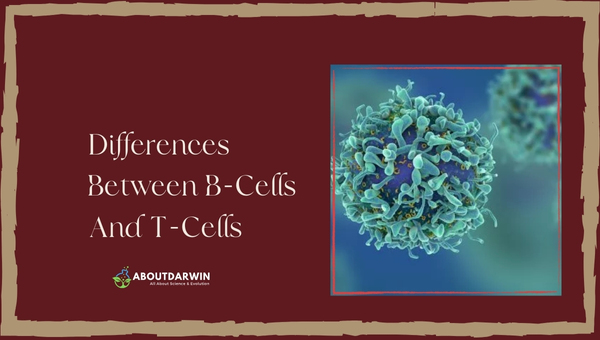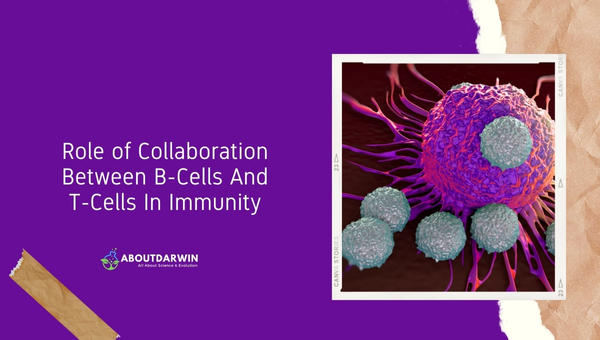Physical Address
304 North Cardinal St.
Dorchester Center, MA 02124
Hello there! If you have ever been curious about what keeps your body safe from harmful invaders, you’ve come to the right place. Today, I’m going to introduce you to two important warriors in your immune system – B-cells and T-cells.
These are not some sci-fi innovations but very real, vital components of our bodies that help us fight off diseases every day.
The world of B-cells and T-cells might seem complex at first glance with its scientific terminology and detailed processes. Fear not, though, as I’ll try my best to make it as uncomplicated and engaging as possible.
So, buckle up for an exciting journey through your immune system, where we learn about these microscopic marvels’ roles, differences, and how they work together to protect you!
Contents
Here’s a markdown table for the differences between B-cells and T-cells:

| B-Cells | T-Cells | |
|---|---|---|
| Origin | Produced in the bone marrow | Produced in the bone marrow, mature in the thymus |
| Surface receptor | B-cell receptor (BCR) | T-cell receptor (TCR) |
| Function | Produce antibodies, involved in humoral immune response | Directly kill infected cells, involved in cell-mediated immune response |
| Major histocompatibility complex (MHC) | B-cells present antigens to helper T-cells using MHC class II | T-cells recognize antigens presented by antigen-presenting cells (APCs) using MHC class I or II |
| Activation | Activated by direct binding of antigens to BCR or by helper T-cells | Activated by antigens presented by APCs |
| Types | Mainly two types: plasma cells (produce antibodies) and memory B-cells | Several types, including helper T-cells, cytotoxic T-cells, and memory T-cells |
| Memory response | B-cells retain memory of antigens for future immune responses | T-cells retain memory of antigens for future immune responses |
On comparing the surface receptors of B-cells and T-cells, we find a remarkable difference. While the B-cell receptors, known as BCRs, can bind directly to antigens – be it bacterial toxins or parts of viruses – the T-cell receptors, or TCRs, function differently.
They recognize antigens only when it is presented on an MHC molecule by other cells like macrophages.
B-cell and T-cell actions also look quite distinct once they encounter a pathogen. B-cells get busy producing specific antibodies to fight off pathogens floating in your body fluids. These antibodies latch onto foreign entities, marking them for destruction by other immune cells.
On the flip side, when a virus barges into your body and starts turning healthy cells into virus-producing factories – that’s when you’ll appreciate the brutal efficiency of your T-cells!
These badass defenders deal with threats, not just as dumb muscle but employing cunning tactics, too! They stimulate other immune cells or directly attack the infected ones, ensuring our bodies stay clear of such atrocious invasions.
Also Read: Cetrimide Agar: Uncover Its Composition, Principle, and More
Let’s start our deep dive by discussing B-cells, an integral part of our immune system. B-cells act as the body’s intelligence unit.
Produced within our bone marrow, these powerful cells patrol throughout our bodies, ready to identify and target harmful foreign invaders like bacteria or viruses. Their central purpose? To initiate an immediate response when we’re faced with any health threats.
Perhaps the most crucial function of B-cells is that they are expert manufacturers of antibodies. When a B-cell recognizes a pathogen, it goes into overdrive and starts producing these antibodies – specialized proteins designed to neutralize the particular virus or bacterium in question.
With their remarkable capabilities, isn’t it interesting how something so small can play such a big role in keeping us healthy? Now, let’s get familiar with rowdy roommates of B-cells – the T-cells!
And where do these powerful B-cells come from? They originate in our bone marrow – the soft, spongy tissue found in the center of our bones. Can you believe that such vital cells evolve in such a smooth and squishy place? It makes one look at one’s own body with newfound respect.
Regarding their functions, B-cells are true multitaskers of the immune system. From production to maturation, they remain in the bone marrow until properly developed.
Once mature, they are released into our blood circulation and lymphatic system, acting as vigilant guards against unwelcome intruders.
Their main duty includes recognizing pathogens’ unique characteristics and manufacturing tailored antibodies to mark these invaders for destruction.
They also possess a remarkable memory function that recalls previous threats so that future responses can be much swifter and more efficient! It is a good thing because we all could use such protégés on the front lines of our health!
Alright, so we’ve talked a bit about the key role B-cells play in producing antibodies – but what does that mean? Allow me to explain.
When our body is faced with an infection—like, say, a nasty flu or cold—B-cells spring into action. The moment these cells spot the foreign invaders (also known as antigens), they start creating an army of antibodies, each custom-designed to latch onto that particular type of invader.
Here’s how it works:
And voila! That’s how our body mounts its line of defense against pathogenic mischief-makers! But remember, while celebrating this microscopic marvel, let’s not forget that its partner-in-crime (or should I say partner-in-health?), T-cell still has stunning capabilities waiting for us in subsequent paragraphs.
Also Read: Unraveling Potato Dextrose Agar (PDA): Principle & More
Now, let’s turn our spotlight to T-cells, another vital cog in our immune system’s machinery. Much like their B-cell counterparts, T-cells are on constant high alert in our bodies, ever vigilant against possible health threats. But there is something that sets them apart. Intrigued about what it might be? Keep reading!
Similarly originating from the bone marrow, T-cells then decide to travel and mature in a small organ named thymus (hence the name ‘T’ cells!).
And here’s where they get fascinating: While B-cells can be thought of as expert archers sniping out invaders from a distance, T-cells indulge in close combat!
They latch onto infected cells and destroy them directly – thereby playing a crucial role in what we call cell-mediated immunity. How about that for an inside job? Now let’s take a closer look at those refined functions…
With T-cells, we see another glorious dance of nature as they originate from the very same place as B-cells, our bone marrow.
But here’s where they shake things up a bit – unlike their B-cell brethren who mature right where they’re produced, T-cells decide to take a journey to another organ called the thymus (no prizes for guessing how the ‘T’ in T-cells came to be). It is within these confines that these cells grow, mature, and get armed with immune-functioning capabilities.
Now that we’ve explored their intriguing origins let’s talk about what exactly these cells do. T-cell functions can truly boggle the mind! They fluctuate from seeking and destroying infected cells directly (also known as cytotoxic or killer T-cells) to helping other immune cells perform optimally (helper T-cells).
There are even regulatory T-cells whose job is to keep everyone in check and avoid an overzealous immune response! Through all this tireless work, they maintain our health behind the scenes every single day. And trust me, no one could ask for a better support system!
Now, let’s delve a bit deeper into T-cell’s main responsibility – cell-mediated immunity. This whole process is like an invisible war waged inside our bodies where T-cells play the role of skilled soldiers on the front lines!
Here goes how it works:
This active, warzone-like action distinguishes cell-mediated immunity from antibody-based immunity provided by B-cells. While the B-cell step involves long-range warfare through antibodies, T-cells prefer getting up close and personal with their targets!
Have you got it? I hope that helps clear up some of that immune system fog! Next, shall we examine some contrast between our two types of cells under discussion? Buckle up for some cellular comparative study…
Recognizing the individual roles of B-cells and T-cells is just half the story. The real magic unfolds when these two come together to give us a full-bodied immune response. But how exactly do they collaborate?

Let’s dissect this:
Doesn’t it appear like a choreographed ballet within our bodies where each cell knows its part? This exquisite dance between B-cell and T-cell results in an effective immune response against pathogens, demonstrating that sometimes teamwork makes immunity work! Let’s move forward to grasp more about such exciting bodily ventures!
Also Read: Earth’s Geomagnetic Reversal: The Phenomenon of Polarity Flip
While B-cells produce antibodies to fight infection, T-cells protect people from getting infected by destroying cancerous and infected cells.
Helper T cells stimulate the B cell through the binding of CD40L on the T cell to CD40 on the B cell, through the interaction of other TNF-TNF-receptor family ligand pairs, and by the directed release of cytokines.
Helper T cells are arguably the most important cells in adaptive immunity, as they are required for almost all adaptive immune responses. They not only help activate B cells to secrete antibodies and macrophages to destroy ingested microbes, but they also help activate cytotoxic T cells to kill infected target cells.
B cells act as antigen-presenting cells to induce T cell responses to specific antigens. B cells also have roles in the development and maintenance of memory T cells (6, 66–68) to provide optimal T cell response to antigens in long-term antigen exposure.
The adaptive immune system is made up of T lymphocytes in the tissue between the body’s cells. B lymphocytes are also found in the tissue between the body’s cells—antibodies in the blood and other bodily fluids.
Also Read: Unveiling MacConkey Agar: Composition, Principles, and Uses
So, there you have it! A quick yet in-depth look at B-Cells and T-Cells – the unsung heroes within us. These microscopic warriors work tirelessly to ensure our body’s defenses are robust, efficient, and ready for action.
They might seem like tiny entities from a scientific textbook, but the impact they accomplish is massive.
Your newfound understanding of B-Cells and T-Cells not only equips you with interesting facts to share on your next dinner date but is also a gentle reminder to lead a healthy lifestyle that promotes optimal immune functions.
So here’s to staying fascinated by our internal universe and doing everything we can to keep it thriving!